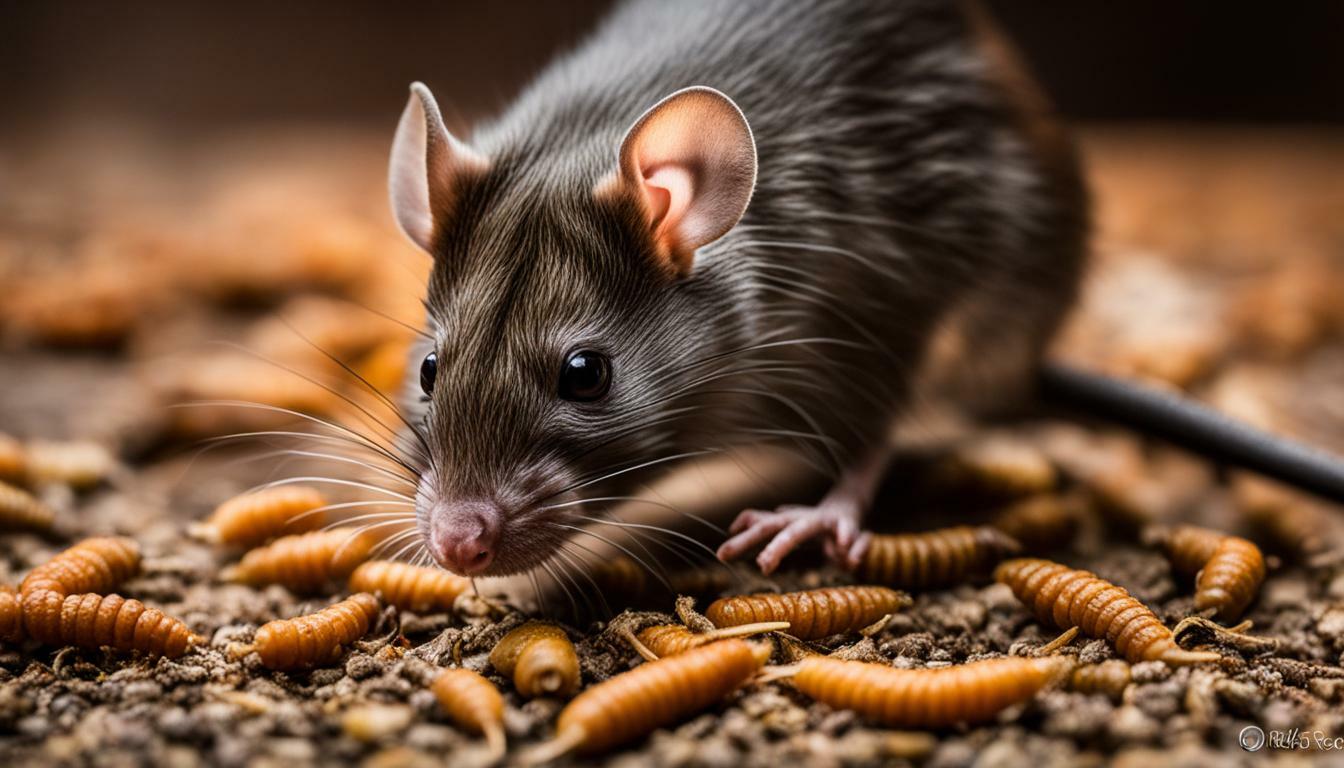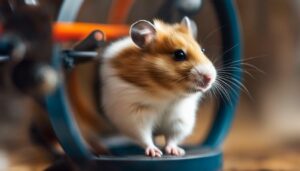Rats are known to enjoy a varied diet, but can they safely consume mealworms? In this article, we will explore the question of whether rats can eat mealworms and provide an overview of their diet habits.
Key Takeaways:
- Rats can eat mealworms, but it’s best to offer them dried or processed ones instead of live ones.
- Mealworms are a great source of protein for rats, but they should not be the only food in their diet as they need other essential nutrients as well.
- It’s recommended to feed rats dried or freeze-dried mealworms, as living ones can disrupt their stomach.
- Rats may take some time to get used to mealworms, but they will eventually enjoy them.
- A proper amount of mealworms for a rat’s meal is around 40-45 mealworms, as they need about 5-6 grams of protein food daily.
Mealworms as a Source of Protein for Rats
Mealworms can provide rats with a valuable source of protein, essential for their overall nutrition. Rats are omnivores and require a balanced diet that includes both plant-based and animal-based proteins. While rats can consume other sources of protein such as meat, fish, and insects, mealworms are particularly beneficial due to their high protein content.
As a convenient and readily available food source, mealworms offer a nutritious option for pet rats. They are packed with essential amino acids that support muscle development, growth, and maintenance. Protein also plays a crucial role in maintaining a rat’s immune system, promoting healthy skin and fur, and aiding in digestion.
When feeding mealworms to rats, it is important to ensure that they are dried or processed. Live mealworms can pose a risk to rats as they may bite or harm the rat’s digestive system. Dried or freeze-dried mealworms are a safe alternative and provide rats with the same nutritional benefits without the potential hazards.
| Benefits of Mealworms for Rats: |
|---|
| High protein content |
| Essential amino acids |
| Promotes muscle development |
| Supports immune system |
| Maintains healthy skin and fur |
| Aids in digestion |
Introducing mealworms into a rat’s diet may require some patience and persistence. Rats can be cautious about trying new foods, so it is recommended to start by offering small amounts of mealworms alongside their regular diet. Gradually increase the portion size as the rat becomes more accustomed to the taste and texture. With time, rats will often accept mealworms as a tasty and nutritious addition to their meals.
In conclusion, mealworms can be a beneficial protein source for rats, providing essential nutrients for their overall well-being. However, it is crucial to offer dried or processed mealworms to ensure the safety and health of the rats. Remember to gradually introduce mealworms into their diet and incorporate a variety of other foods to create a balanced nutritional intake for optimal rat nutrition.
Dried or Processed Mealworms for Rats
To prevent digestive issues, it is recommended to feed rats dried or freeze-dried mealworms rather than live ones. While rats can technically consume live mealworms, there is a risk of the worms disrupting their stomach due to their movement. Dried or processed mealworms, on the other hand, provide a safer option for your pet rat’s dietary needs.
“Feeding rats dried or freeze-dried mealworms is preferable to live ones.”
When purchasing dried or freeze-dried mealworms, ensure that they are of high quality and free from any contaminants. This will help maintain the nutritional value of the mealworms and ensure the safety of your pet rat. It’s important to note that mealworms should not be the sole source of nutrition in a rat’s diet. While they are a great source of protein, rats require a balanced diet that includes other essential nutrients.
“Rats need a well-rounded diet that includes other essential nutrients.”
| Safe Foods for Rats | Foods to Avoid | |
|---|---|---|
| Protein | Dried or freeze-dried mealworms | Raw beans, wild insects |
| Fruits and Vegetables | Apple slices, carrot sticks, cucumber | Mango peels, lemon peels, sweet potato |
| Others | Clean water | Chocolate, caffeine |
“Offer rats a variety of safe fruits and vegetables in moderation.”
When introducing mealworms into a rat’s diet, it may take some time for them to become accustomed to the new food. Start by offering small quantities and gradually increase the amount over time. Rats are curious creatures and will likely enjoy the added variety in their diet. Just be sure to monitor their intake and adjust accordingly to maintain a balanced nutritional intake.
“Gradually introduce mealworms into your rat’s diet to ensure acceptance.”
Introducing Mealworms to a Rat’s Diet
Rats may take some time to adjust to the taste and texture of mealworms, but with patience and persistence, they can learn to enjoy them. These nutritious little worms can be a valuable addition to their diet, providing essential protein and other nutrients. Here are some tips on how to introduce mealworms into your rat’s diet.
Start Slowly
When introducing mealworms to your rat, start by offering a small amount alongside their regular food. This allows them to become familiar with the new food without overwhelming their taste buds. Gradually increase the amount of mealworms over time, monitoring their response and adjusting accordingly.
Try Different Preparations
Experiment with different preparations to see which your rat prefers. Dried or freeze-dried mealworms are often easier to handle and store, making them a convenient option. You can also try crushing or chopping the mealworms into smaller pieces to make them more manageable for your rat.
Combine with Other Foods
Incorporate mealworms into a balanced diet by mixing them with other foods your rat enjoys. You can try adding them to their regular pellets, mixing them in with fresh fruits and vegetables, or even making homemade treats using mealworms as an ingredient. This way, your rat will receive a well-rounded nutritional intake.
Remember, every rat is unique, and it may take some time for them to warm up to mealworms. Be patient and observe their behavior and response to ensure they are comfortable with this new addition to their diet. With time, mealworms can become a tasty and nutritious treat that your rat will happily devour.
Table: Introduction of Mealworms into a Rat’s Diet
| Step | Action |
|---|---|
| 1 | Start by offering a small amount of mealworms alongside your rat’s regular food. |
| 2 | Gradually increase the amount of mealworms over time, monitoring your rat’s response. |
| 3 | Try different preparations such as dried or freeze-dried mealworms. |
| 4 | Combine mealworms with other foods your rat enjoys to create a balanced diet. |
| 5 | Observe your rat’s behavior and adjust the amount of mealworms accordingly. |
Proper Amount of Mealworms for Rats
A recommended serving size for rats is around 40-45 dried or freeze-dried mealworms per meal. Rats have a high protein requirement, and mealworms are a valuable source of protein for them. Mealworms can provide the essential amino acids that rats need for growth, development, and overall health. However, it’s important to remember that mealworms should not be the sole food in a rat’s diet.
Table 1: Protein Content of Mealworms (per 100 grams)
| Protein | 18 grams |
|---|---|
| Fat | 13 grams |
| Carbohydrates | 2 grams |
Rats also require other essential nutrients, such as vitamins, minerals, and fiber, which they can obtain from a varied diet. It’s best to offer rats a balanced meal that includes a mix of protein-rich foods like mealworms, along with fresh fruits, vegetables, and grains. This will ensure that they receive a well-rounded nutritional intake.
“Rats have specific nutritional needs, and a varied diet is crucial for their overall well-being.”
When introducing mealworms into a rat’s diet, it’s important to start gradually. Begin by offering a small amount of mealworms and observe how the rat responds. Some rats may take to mealworms right away, while others may be more hesitant. Keep offering mealworms over time, and eventually, most rats will come to enjoy them as part of their regular diet.
Summary: Rats can eat dried or freeze-dried mealworms in moderation as part of a balanced diet. A recommended serving size is around 40-45 mealworms per meal, providing rats with the protein they need. It’s important to gradually introduce mealworms into a rat’s diet and offer a variety of other foods to ensure their overall nutritional needs are met.
Essential Nutrients in a Rat’s Diet
While mealworms are a valuable source of protein, rats also require other nutrients for optimal health. It’s important to provide a balanced diet that includes a variety of foods to meet their nutritional needs. Here are some essential nutrients that should be included in a rat’s diet:
- Carbohydrates: Rats need carbohydrates for energy. Offer them a mix of grains like oats, barley, and brown rice.
- Fats: Healthy fats are an important part of a rat’s diet. Include small amounts of seeds, nuts, and vegetable oils.
- Protein: In addition to mealworms, rats require other sources of protein such as lean meats, eggs, and soy products.
- Vitamins and Minerals: Rats need a variety of vitamins and minerals for overall health. Offer them fresh fruits and vegetables such as apples, carrots, and leafy greens.
- Water: Make sure your rat has access to clean, fresh water at all times. It’s important for proper digestion and hydration.
Incorporating these essential nutrients into your rat’s diet will help ensure they receive a well-rounded nutritional intake. It’s important to provide a variety of foods to keep their diet interesting and prevent boredom. Remember to introduce new foods gradually and monitor their response to ensure they tolerate them well.
“A balanced diet is the key to a healthy rat.”
To help you keep track of your rat’s nutritional intake, here is a table showing the recommended daily amount of each essential nutrient:
| Nutrient | Recommended Daily Amount |
|---|---|
| Carbohydrates | 15-20% |
| Fats | 5-10% |
| Protein | 16-20% |
| Vitamins and Minerals | Varies, provide a mix of fruits and vegetables |
| Water | Always available |
By following these guidelines and providing a well-balanced diet, you can ensure your rat stays healthy and happy.
Foods to Avoid Feeding Rats
It is important to steer clear of feeding rats foods such as chocolate, caffeine, mango peels, and raw beans, as these can have adverse effects on their well-being. Rats have sensitive digestive systems, and certain foods can be toxic or cause digestive issues for them. Here is a list of foods to avoid feeding rats:
- Chocolate: Chocolate contains theobromine, a substance that can be toxic to rats and cause symptoms such as vomiting, diarrhea, and even seizures.
- Caffeine: Rats are highly sensitive to caffeine and should not consume caffeinated beverages or foods. Caffeine can lead to heart palpitations, restlessness, and increased blood pressure in rats.
- Mango peels: While rats can eat small amounts of mango flesh, the peels should be avoided as they can be difficult for rats to digest and may cause stomach upset.
- Raw beans: Raw beans, including kidney beans, can contain toxins that are harmful to rats. These toxins can cause digestive issues and even lead to illness or death in severe cases.
Additionally, it is important to avoid feeding rats any wild insects or bugs that have not been specifically bred and raised for pet consumption. While rats may eat insects in the wild, they can be exposed to pesticides or parasites that can be harmful to them.
By following these guidelines and avoiding these foods, you can ensure the well-being and health of your pet rats.
| Foods to Avoid Feeding Rats: |
|---|
| Chocolate |
| Caffeine |
| Mango peels |
| Raw beans |
Mealworms in the Diets of Other Rodents
Mealworms can be a safe and nutritious addition to the diets of various rodent species, including rats. These small, beetle larvae are packed with protein and essential nutrients, making them an excellent supplement to a balanced diet for these critters. In addition to rats, other rodents like mice, hamsters, and squirrels can also benefit from the nutritional value of mealworms.
Rats, in particular, can find mealworms to be a tasty and satisfying addition to their meals. These small creatures have a natural instinct to forage and consume a diverse range of foods. By incorporating mealworms into their diet, rats can enjoy a protein-rich treat that helps meet their nutritional needs.
When feeding mealworms to other rodents, it’s important to follow similar guidelines as with rats. Offer dried or freeze-dried mealworms instead of live ones, as living mealworms can disrupt the digestive system of these animals. Additionally, it’s essential to introduce mealworms gradually into their diet and ensure they have access to other fresh fruits and vegetables for a well-rounded nutritional intake.
| Rodent Species | Suitable Diet Plan |
|---|---|
| Rats | Offer dried or freeze-dried mealworms as a protein-rich supplement, along with a balanced diet that includes fresh fruits and vegetables. |
| Mice | Include dried mealworms as a protein source in their diet, alongside a variety of other foods such as grains, seeds, and fruits. |
| Hamsters | Provide dried mealworms in moderation, coupled with a mixture of grains, seeds, and vegetables to ensure a well-rounded diet. |
| Squirrels | Offer dried or freeze-dried mealworms as part of a varied diet that includes nuts, seeds, fruits, and vegetables. |
By incorporating mealworms into the diets of these rodent species, pet owners can provide them with a diverse range of nutrients and ensure they receive a well-rounded diet. However, it’s important to consult with a veterinarian or a rodent nutrition expert to determine the appropriate quantities and frequency of mealworms for your specific pet.
Providing a Balanced Diet for Rats
In addition to mealworms, rats should be offered fresh fruits and vegetables in moderation to maintain a balanced diet. These foods provide important nutrients such as vitamins, minerals, and fiber that are essential for a rat’s overall health and well-being. Some suitable fruits and vegetables for rats include apples, carrots, green beans, broccoli, and leafy greens like kale or spinach. It’s important to wash these foods thoroughly and remove any seeds or pits that could be harmful to rats.
When introducing fresh produce to a rat’s diet, it’s best to start with small amounts and gradually increase the portion size. This allows their digestive system to adjust and reduces the risk of stomach upset. Rats have delicate digestive systems, so it’s crucial to avoid offering fruits and vegetables that are high in sugar, such as grapes or bananas, as excessive sugar intake can lead to obesity and other health issues.
It’s also important to note that while fresh fruits and vegetables are a great addition to a rat’s diet, they should not replace their main source of nutrition. Mealworms should still be provided as a protein-rich food source, but it’s crucial to ensure a variety of other foods are included in their diet to meet all of their nutritional needs. Rats thrive on a diverse diet that includes a mix of protein, carbohydrates, fats, and other essential nutrients.
Sample Rat Diet Plan:
| Meal | Food Items |
|---|---|
| Breakfast | Small portion of premium rat pellets, 5-6 dried mealworms |
| Lunch | Small portion of fresh fruits/vegetables (e.g., a slice of apple or a few green beans) |
| Dinner | Small portion of premium rat pellets, 5-6 dried mealworms |
Remember, it’s crucial to monitor your rat’s overall health and adjust their diet accordingly. If you notice any unusual weight gain or loss, changes in appetite, or digestive issues, consult a veterinarian who specializes in small animals for guidance and advice on their nutritional needs.
Housing and Care for Pet Rats
To ensure the well-being of pet rats, they should have access to clean water at all times and live in a secure, well-ventilated cage with appropriate bedding. Rats are active creatures and require a cage that is spacious enough for them to move around and explore. It’s recommended to provide a cage with multiple levels or platforms to allow for climbing and exercise.
When setting up the cage, choose bedding materials that are safe and comfortable for rats. Avoid cedar or pine shavings as they can be harmful to their respiratory system. Opt for paper-based bedding or fleece liners that are easy to clean and maintain hygiene in the cage. Regularly cleaning the cage is essential to prevent the buildup of ammonia and maintain a healthy living environment for your rats.
Rats are intelligent animals that require mental stimulation and enrichment. Provide them with toys, tunnels, and hiding spots to keep them engaged and entertained. Regular interaction with your rats is also crucial for their well-being. Spend time playing with them, providing gentle handling, and offering opportunities for socialization to build trust and strengthen the bond between you and your pets.
| Essential Housing and Care Tips for Pet Rats |
|---|
| 1. Cage Size: Ensure the cage is spacious enough for rats to roam, climb, and explore. |
| 2. Ventilation: Provide a well-ventilated cage to maintain air circulation and prevent respiratory issues. |
| 3. Bedding: Choose safe bedding materials such as paper-based bedding or fleece liners. |
| 4. Hygiene: Clean the cage regularly to prevent the buildup of ammonia and maintain a clean living environment. |
| 5. Enrichment: Provide toys, tunnels, and hiding spots for mental stimulation and entertainment. |
| 6. Interaction: Spend time playing with your rats, gently handling them, and providing opportunities for socialization. |
By following these housing and care tips, you can create a comfortable and stimulating environment for your pet rats. Remember to always monitor their health and behavior, and consult a veterinarian if you have any concerns. With proper care and attention, your rats can thrive and lead happy, healthy lives as beloved members of your family.
Handling and Interacting with Rats
It is important to handle rats gently and interact with them daily to build a bond and promote their overall well-being. Rats are social animals that thrive on companionship and positive human interactions. By spending time with your pet rat, you can establish trust, encourage their natural curiosity, and provide mental stimulation.
To handle rats properly, it is recommended to approach them calmly and avoid making sudden movements that may startle them. Supporting their body with both hands and allowing them to explore your hands and arms can help them feel secure. Remember to handle them gently and avoid squeezing or applying excessive pressure.
Interacting with your rat can include activities such as playing with toys, offering treats, or teaching them simple tricks. Rats are intelligent creatures that enjoy learning and problem-solving, so providing them with enrichment activities can help keep them mentally stimulated and engaged.
Handling Tips:
- Always wash your hands before and after handling your rat to prevent the spread of bacteria.
- Ensure that the area where you interact with your rat is safe and free from potential hazards.
- Supervise interactions between children and rats to ensure the well-being of both parties.
Quote: “Rats are incredibly intelligent and can form strong bonds with their human caretakers. By handling them gently and providing daily interaction, you can foster a loving and trusting relationship.” – Rat Care Expert
| Activity | Frequency |
|---|---|
| Handling and cuddling | Daily |
| Playing with toys | Regularly |
| Training sessions | 2-3 times per week |
Remember to observe your rat’s body language during interactions. If they show signs of distress, such as teeth chattering or flattening their ears, it’s important to give them space and reassess the situation. Each rat has its own unique personality, so it’s essential to respect their boundaries and preferences.
Summary:
In conclusion, handling and interacting with rats is crucial for their well-being. By approaching them gently, engaging in regular playtime, and providing mental stimulation, you can build a strong bond with your pet rat and ensure their happiness. Remember to prioritize their safety, monitor their body language, and respect their individual needs and preferences. With proper care and attention, your pet rat can thrive in your loving and nurturing environment.
Conclusion
Rats can safely eat dried or processed mealworms as part of a balanced diet, but it’s crucial to ensure they receive other essential nutrients as well. Mealworms are an excellent source of protein for rats, but they should not be the sole food in their diet.
Feeding rats dried or freeze-dried mealworms is recommended, as living ones can disrupt their stomach. It may take some time for rats to get used to mealworms, but with patience, they will eventually enjoy this nutritious treat.
The appropriate amount of mealworms to include in a rat’s meal is around 40-45, as rats require approximately 5-6 grams of protein food daily. However, it’s important to remember that mealworms should not be the only source of nutrition for rats.
When incorporating mealworms into a rat’s diet, it’s vital to avoid feeding them certain foods that can be harmful to their health. Chocolate, caffeine, mango peels, lemon peels, sweet potato, raw beans, and wild insects should be avoided.
It’s worth noting that mealworms can also be included in the diets of other rodents like mice, hamsters, and squirrels, as they provide a valuable source of protein.
When introducing mealworms into a rat’s diet, it’s advisable to do so gradually. Additionally, rats should be provided with fresh fruits and vegetables in moderation to ensure a well-rounded nutritional intake.
Rats should have access to clean water at all times and live in a secure, well-ventilated cage with appropriate bedding. It’s crucial to handle rats gently and interact with them daily to promote their overall well-being.
FAQ
Can rats eat mealworms?
Yes, rats can eat mealworms. They are a great source of protein for rats.
Should I offer rats live or dried mealworms?
It is recommended to offer rats dried or processed mealworms instead of live ones to avoid stomach disruption.
How can I introduce mealworms to a rat’s diet?
You can gradually introduce mealworms into a rat’s diet and allow them time to get used to this new food.
What is the proper amount of mealworms for a rat’s meal?
A proper amount of mealworms for a rat’s meal is around 40-45 mealworms, as rats need about 5-6 grams of protein food daily.
Can rats eat mealworms as their only food?
No, mealworms should not be the only food in a rat’s diet. Rats need other essential nutrients as well.
Are there any foods I should avoid feeding rats?
Yes, you should avoid feeding rats certain foods such as chocolate, caffeine, mango peels, lemon peels, sweet potato, raw beans, and wild insects as they can be harmful to their health.
Can other rodents like mice, hamsters, and squirrels eat mealworms?
Yes, mealworms can also be included in the diets of other rodents like mice, hamsters, and squirrels.
What should I provide in a balanced diet for rats?
In addition to mealworms, it is important to incorporate fresh fruits and vegetables into a rat’s diet to ensure a well-rounded nutritional intake.
What are the housing and care requirements for pet rats?
Pet rats should live in a secure, well-ventilated cage and have access to clean water at all times.
How should I handle and interact with pet rats?
It is recommended to handle rats gently and interact with them daily in a positive manner.




